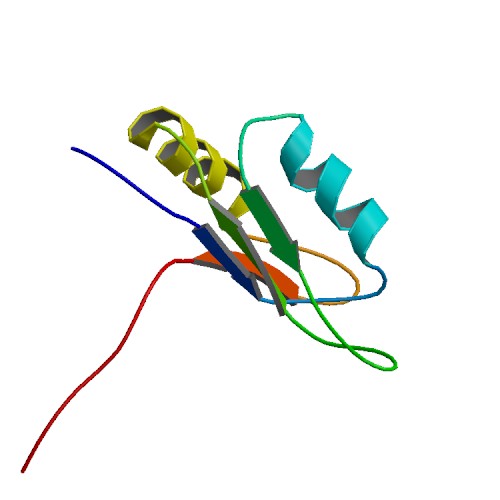ELAVL4
Jump to navigation
Jump to search
| ELAV (embryonic lethal, abnormal vision, Drosophila)-like 4 (Hu antigen D) | |||||||||||||
|---|---|---|---|---|---|---|---|---|---|---|---|---|---|
 PDB rendering based on 1d8z. | |||||||||||||
| |||||||||||||
| Identifiers | |||||||||||||
| Symbols | ELAVL4 ; HUD; PNEM | ||||||||||||
| External IDs | Template:OMIM5 Template:MGI HomoloGene: 40729 | ||||||||||||
| |||||||||||||
| RNA expression pattern | |||||||||||||
 | |||||||||||||
| More reference expression data | |||||||||||||
| Orthologs | |||||||||||||
| Template:GNF Ortholog box | |||||||||||||
| Species | Human | Mouse | |||||||||||
| Entrez | n/a | n/a | |||||||||||
| Ensembl | n/a | n/a | |||||||||||
| UniProt | n/a | n/a | |||||||||||
| RefSeq (mRNA) | n/a | n/a | |||||||||||
| RefSeq (protein) | n/a | n/a | |||||||||||
| Location (UCSC) | n/a | n/a | |||||||||||
| PubMed search | n/a | n/a | |||||||||||
ELAV (embryonic lethal, abnormal vision, Drosophila)-like 4 (Hu antigen D), also known as ELAVL4, is a human gene.[1]
References
Further reading
- Dalmau J, Furneaux HM, Cordon-Cardo C, Posner JB (1992). "The expression of the Hu (paraneoplastic encephalomyelitis/sensory neuronopathy) antigen in human normal and tumor tissues". Am. J. Pathol. 141 (4): 881–6. PMID 1415481.
- Szabo A, Dalmau J, Manley G; et al. (1991). "HuD, a paraneoplastic encephalomyelitis antigen, contains RNA-binding domains and is homologous to Elav and Sex-lethal". Cell. 67 (2): 325–33. PMID 1655278.
- Graus F, Ferrer I (1990). "Analysis of a neuronal antigen (Hu) expression in the developing rat brain detected by autoantibodies from patients with paraneoplastic encephalomyelitis". Neurosci. Lett. 112 (1): 14–8. PMID 2166930.
- Sekido Y, Bader SA, Carbone DP; et al. (1994). "Molecular analysis of the HuD gene encoding a paraneoplastic encephalomyelitis antigen in human lung cancer cell lines". Cancer Res. 54 (18): 4988–92. PMID 8069866.
- Muresu R, Baldini A, Gress T; et al. (1993). "Mapping of the gene coding for a paraneoplastic encephalomyelitis antigen (HuD) to human chromosome site 1p34". Cytogenet. Cell Genet. 65 (3): 177–8. PMID 8222755.
- Torà M, Graus F, de Bolòs C, Real FX (1997). "Cell surface expression of paraneoplastic encephalomyelitis/sensory neuronopathy-associated Hu antigens in small-cell lung cancers and neuroblastomas". Neurology. 48 (3): 735–41. PMID 9065557.
- Lazarova DL, Spengler BA, Biedler JL, Ross RA (1999). "HuD, a neuronal-specific RNA-binding protein, is a putative regulator of N-myc pre-mRNA processing/stability in malignant human neuroblasts". Oncogene. 18 (17): 2703–10. doi:10.1038/sj.onc.1202621. PMID 10348344.
- Park S, Myszka DG, Yu M; et al. (2000). "HuD RNA recognition motifs play distinct roles in the formation of a stable complex with AU-rich RNA". Mol. Cell. Biol. 20 (13): 4765–72. PMID 10848602.
- Wang X, Tanaka Hall TM (2001). "Structural basis for recognition of AU-rich element RNA by the HuD protein". Nat. Struct. Biol. 8 (2): 141–5. doi:10.1038/84131. PMID 11175903.
- Beckel-Mitchener AC, Miera A, Keller R, Perrone-Bizzozero NI (2002). "Poly(A) tail length-dependent stabilization of GAP-43 mRNA by the RNA-binding protein HuD". J. Biol. Chem. 277 (31): 27996–8002. doi:10.1074/jbc.M201982200. PMID 12034726.
- Behrends U, Jandl T, Golbeck A; et al. (2002). "Novel products of the HUD, HUC, NNP-1 and alpha-internexin genes identified by autologous antibody screening of a pediatric neuroblastoma library". Int. J. Cancer. 100 (6): 669–77. doi:10.1002/ijc.10550. PMID 12209604.
- Aronov S, Aranda G, Behar L, Ginzburg I (2003). "Visualization of translated tau protein in the axons of neuronal P19 cells and characterization of tau RNP granules". J. Cell. Sci. 115 (Pt 19): 3817–27. PMID 12235292.
- Angenstein F, Evans AM, Settlage RE; et al. (2002). "A receptor for activated C kinase is part of messenger ribonucleoprotein complexes associated with polyA-mRNAs in neurons". J. Neurosci. 22 (20): 8827–37. PMID 12388589.
- Deschenes-Furry J, Belanger G, Perrone-Bizzozero N, Jasmin BJ (2003). "Post-transcriptional regulation of acetylcholinesterase mRNAs in nerve growth factor-treated PC12 cells by the RNA-binding protein HuD". J. Biol. Chem. 278 (8): 5710–7. doi:10.1074/jbc.M209383200. PMID 12468554.
- Strausberg RL, Feingold EA, Grouse LH; et al. (2003). "Generation and initial analysis of more than 15,000 full-length human and mouse cDNA sequences". Proc. Natl. Acad. Sci. U.S.A. 99 (26): 16899–903. doi:10.1073/pnas.242603899. PMID 12477932.
- Plonquet A, Garcia-Pons F, Fernandez E; et al. (2004). "Peptides derived from the onconeural HuD protein can elicit cytotoxic responses in HHD mouse and human". J. Neuroimmunol. 142 (1–2): 93–100. PMID 14512168.
- Saito K, Fujiwara T, Katahira J; et al. (2004). "TAP/NXF1, the primary mRNA export receptor, specifically interacts with a neuronal RNA-binding protein HuD". Biochem. Biophys. Res. Commun. 321 (2): 291–7. doi:10.1016/j.bbrc.2004.06.140. PMID 15358174.
- Rousseau A, Benyahia B, Dalmau J; et al. (2005). "T cell response to Hu-D peptides in patients with anti-Hu syndrome". J. Neurooncol. 71 (3): 231–6. doi:10.1007/s11060-004-1723-1. PMID 15735910.
- Noureddine MA, Qin XJ, Oliveira SA; et al. (2005). "Association between the neuron-specific RNA-binding protein ELAVL4 and Parkinson disease". Hum. Genet. 117 (1): 27–33. doi:10.1007/s00439-005-1259-2. PMID 15827745.
- Rual JF, Venkatesan K, Hao T; et al. (2005). "Towards a proteome-scale map of the human protein-protein interaction network". Nature. 437 (7062): 1173–8. doi:10.1038/nature04209. PMID 16189514.
| This protein-related article is a stub. You can help Wikipedia by expanding it. |